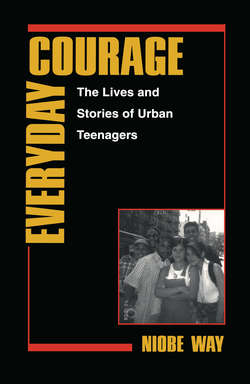Читать книгу Everyday Courage - Niobe Way - Страница 19
На сайте Литреса книга снята с продажи.
Practice
ОглавлениеThe practice or methodology of my research is embedded in the beliefs I have just outlined, and more specifically, in the work of researchers such as Michelle Fine, Joyce Ladner, and Carol Gilligan, who have put these insights associated with the interpretive turn into practice in their studies of human lives.36 Although not all of these researchers have examined the experiences of urban adolescents in particular, all have been deeply influential in the formulation of my questions, my choice of methodology, and the general process of my research. They have provided insight into the ways or methods of exploring and understanding the richness and complexity of life.
Robert White, during the 1950s, was one of the first social science researchers to stress the importance of studying lives in progress. He believed that personality is a constantly evolving system: Both the person and the environment affect each other and undergo continuous change.37 Tracking this change and evolution is critical, according to White, for understanding human development. Furthermore, he asserts that personality is inherently complex and that the method used for studying lives ought to reflect that complexity. He chose the case-study approach over survey methods because he believed that through case studies the intricacies of a person’s personality can best be revealed.38
More recently, Carol Gilligan has underscored the importance of studying lives in progress, and has emphasized, in particular, the importance of listening to individuals speak about their lives. Gilligan and her colleagues at the Harvard Project on Women’s Psychology and Girls’ Development have been a primary source of inspiration and guidance for this study. By paying close attention to their empirical studies, I was able to formulate ways to address the gaps in our knowledge about urban adolescents. Gilligan and her colleagues have spent almost two decades conducting research on the lives of adolescent girls and women and, like the previously cited studies, their approach emphasizes the importance of lived experience. They also focus on coming into relationship with the girls they are studying rather than simply observing and recording the participants’ behaviors or responses. Gilligan and her colleagues perceive the research process as inherently relational—the researcher is as much a part of the “findings” as the research participant. Consequently, discussions of the relationship between the researcher and the researched form a significant part of their analyses.
Through their methods of analysis, they underscore the complexity of development, the “nonlinear, nontransparent orchestration of feelings and thoughts.”39 And in order to reveal such complexity, they concentrate both on what was said (by the interviewee as well as the interviewer) and how the person expressed herself or himself. Their method, furthermore, is explicitly attentive to societal and cultural contexts. They believe the words of adolescents cannot be separated from the culture and the societal context in which they are spoken.
Psychology has lost an awareness of voice and vision, and with it the recognition that a story can be told from more than one angle and a situation seen in different lights. In the absence of voice and vision, the ability to render differences fades into the stark alternatives of a universal standpoint—the presumption of a God’s eye position—or the abandonment to riotous relativism—the claims to have no perspective or terms. We propose to solve our conundrum—to embed psyche and to speak about difference—by recovering voice and vision as concepts that link psyche with body, with relationship, and with culture.40
Psychological theory, and developmental theory in particular, has privileged only certain types of metaphors; namely, the metaphors of stages, steps, positions, and levels. These types of metaphors, found in many developmental metanarratives referred to earlier, have missed the polyphonic nature of human experience.41 Gilligan and her colleagues call for a change in the language of psychology from one of stages, sequences, and linear development to one of musical metaphors such as “point/counterpoint” or “fugue.” The metaphor of a fugue suggests a way to listen to many voices “as themes, and variations on themes” heard in the narratives of people speaking about their lives. These musical metaphors, they assert, better capture the varied nature of human interaction and experiences.
Gilligan and her colleagues have taken the beliefs that characterize the interpretive turn and created a method of listening called “The Listening Guide” (described in the next chapter). Their method of listening underscores the relational nature of research, the possibilities for both understanding and misunderstanding within this relationship, and the abilities of people to speak about their worlds in more than one way.
They warn their readers about the dangers of “striving for safety [or] clarity … at the expense of voice or vision and thus of oversimplifying or reducing the experience of conflict.”42 My own study was motivated by the wish to recognize and retain the potential for complex self-awareness that is usually sacrificed in accounts of urban adolescents for the sake of clarity. Gilligan and her colleagues’ approach treats the research participants as authorities in their own experiences by revealing their voices in the text rather than replacing them with summaries of their stories or interpretations that cannot be questioned by the reader. They are also wary of psychological theories that attempt to explain development before they have “listened to” development. Through “The Listening Guide,” Gilligan and her colleagues encourage the listener to hear the ambiguities, the subtleties, and—in order to avoid the “riotous relativism” of nihilistic indeterminacy—the patterns in each person’s interview.
